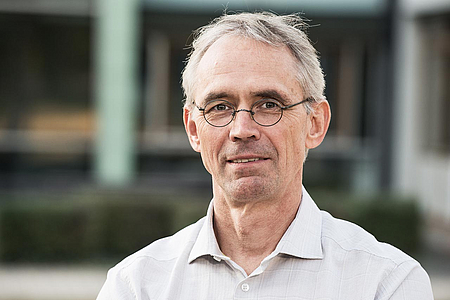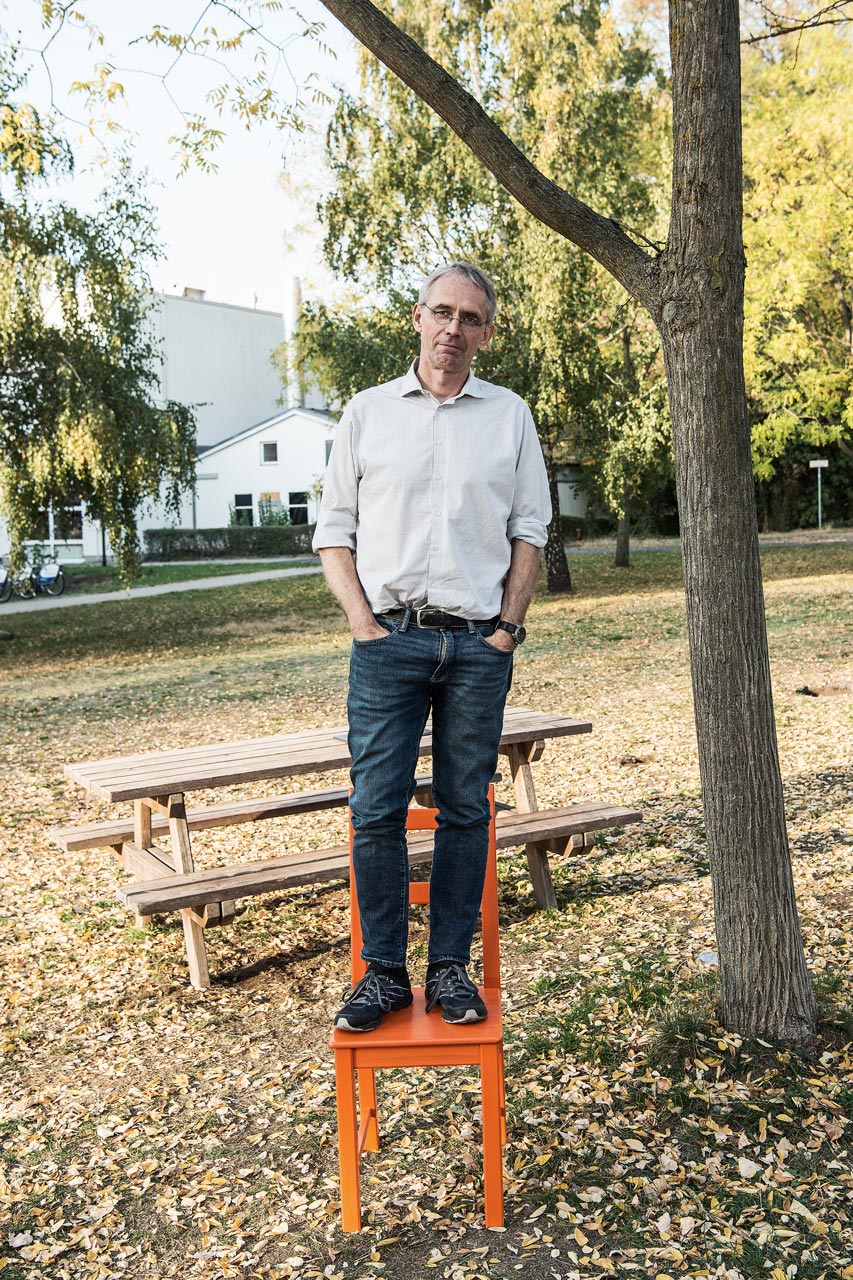How to rediscover your home country as a visiting scientist
Going to the USA used to be regarded by many as a conditio sine qua non for having a scientific career. Today, German laboratories not only attract researchers from all over the world, but also bring emigrated German researchers back to their homeland. The neuroscientist Ulrich Müller also spent most of his scientific career in the USA: as an Einstein BIH Visiting Fellow funded by Stiftung Charité, the Professor from John Hopkins University now regularly returns to Germany.
Professor Müller, in all honesty, is the Einstein BIH Visiting Fellowship a little bit like a homecoming for you?
For me, the program has definitely created a stronger connection with Germany. It’s important to me that my children share that feeling of connection. Above all, it’s a Germany that I didn’t know before. Culturally, it’s completely different to experience a city like Berlin. I was always in Cologne. After I had graduated from the University of Cologne and begun my PhD thesis, I actually only wanted to go to Princeton for one year, but then I was there for three and a half years. That’s where I got to know my wife, who is from Greece originally. After completing our doctoral theses, we went to San Francisco together for our advanced training as postdoctoral researchers at the University of California. At that time, doing your postdoc in the USA was almost a prerequisite for having an academic career. We found our first independent post as group leaders in Switzerland, but afterwards we returned to the USA, as we really liked it there from a scientific viewpoint. So I’ve currently spent the first half of my life in Germany and the second in the USA. Today, I’ve got my three Bs: Baltimore, Boston and Berlin. I work at John Hopkins University in Baltimore, my company’s based in Boston, and I come to Berlin as an Einstein BIH Visiting Fellow.
You once said in an interview that you enjoy more freedom as a researcher in the USA. Would you still say that’s true?
America is extremely dynamic, and you have lots of possibilities and freedoms. However, a lot has changed in Germany and there are many more young research teams today. At the same time, the financial situation of science is rather difficult in the USA. The best research centers in America are extremely well equipped, but there are only a handful of them. The other places don’t necessarily have any advantage over Germany. Traditionally, universities are much more independent in the USA and philanthropy has a certain tradition there. If someone gives money for a new building, they appoint new people. However, procedures are less regulated and it can happen that universities grow too fast and then get into financial difficulties. In the German model, a post also means a secure salary; in the USA, you have to raise 30 to 70 per cent of your salary yourself – sometimes even 100 per cent. But the system sounds harsher than it is in reality. Even if you lose your funding, there are options to tide you over.

Funding program
Einstein BIH Visiting Fellows
Funding period
2016 – 2020
Project title
Mechanotransduction in health and disease
Institution
Max Delbrück Center for Molecular Medicine (MDC)
Since 2016
Bloomberg Distinguished Professor and Director, Developmental Neuroscience, John Hopkins University, Baltimore, USA
2015
Founder of Decibel Therapeutics, Boston, Massachusetts, USA
2013 – 2016
Director and Frank Kershaw Professor of Neuroscience, Dept. Molecular & Cellular Neuroscience, Scripps, La Jolla, USA
Let’s talk about your project: you’re researching the sense of hearing. What brought you, as a neuroscientist, to this topic?
My research team is in fact studying the cortex, a region of the brain. We wanted to study the function of a certain gene that is very pronounced in the cortex. Data from in-vitro models indicated that it affects cell migration in the brain. When we created a knock-out mouse, however, it had no cell migration damage in the brain but it did have hearing impairment. We subsequently established that the gene is also expressed in our auditory cells and that these are damaged. The sense of hearing is one of the mechanical senses that our body uses to convert mechanical signals into electrical signals, as electricity is the language of the nervous system. Perception through mechanical signals is very important. For example, it allows us to feel objects with our fingers or to hear speech. In the human being, the organ of hearing is of course the ear. Air vibrations reach the inner ear and are channelled through the eardrum to the spiral-shaped cochlea, which is constructed similarly to a piano. The sensory cells are arranged in a gradient running from high to low tones. They are called “hair cells”, as they have a large cell body with hairs on the top, called “stereocilia”. If a sound reaches them, the stereocilia are bent by the vibration, and ionic channels on the stereocilia are opened in turn. Nerve tracts then pass on the information to the brain. We wanted to find out how this mechanism is connected to deafness.
You primarily research the Usher syndrome, an illness in which the person concerned is often both deaf and blind. How can it be explained that the genetic defects affect both senses at the same time?
If you look at a row of the stereocilia, you can see that there are three which are arranged like a staircase, from the smallest to the largest. If you move the hair cells, a small filament – the tip link – opens the ionic channels. During the development of the hair cells, not only the tip links but many other filaments help to form this bundle of stereocilia. If these filaments have mutated, the stereocilia don’t develop normally. If they’re missing completely, the stereocilia don’t develop at all and the person is born deaf. In the eye, the same filaments do not serve to build the photo receptors, but they do serve to stabilize them. If the filaments are missing, the photo receptors deteriorate over time and the person slowly goes blind. Again, in the case of mild mutations, sufferers often see normally but become deaf, as the mechanical signal transmission gets worse over time. This is probably because there are thousands of filaments in the eye, whereas there is only a single one for opening the ionic channel in the ear.
Does it involve purely basic research or are your research results also applied in the clinic?
I’m mainly interested in how the body turns mechanical sensory impressions into electrical signals and thereby retains all the information. How do we get an impression of a sound and how is it registered in the brain? However, in our research it became clear to me that the results are of great importance for medicine. I definitely feel a responsibility to develop something for patients from it. We therefore founded a company over two years ago. We’re trying to develop a treatment for hearing loss that doesn’t simply consist of using a hearing aid. Instead, we want to work at the molecular level, i.e. using medications or gene therapy. We’re already conducting the first clinical experiments.
Could you also imagine returning to Germany on a long-term basis?
At the moment, I don’t have any plans to move. In Baltimore, I’ve just built up my research team and particularly my eldest daughter first needs to settle into the new environment. We thought about moving to Germany two years ago, but no suitable opportunity arose. If we were to move to Germany one day, Berlin would be our chosen location. Berlin is an international city with a heart. You get the feeling that it would be possible to live here. I also like Cologne, but I think my family would find it easier to settle down in Berlin. After all, my wife and children have never lived in Germany. A big city with the kind of atmosphere that Berlin has would certainly be very attractive. I’m also very interested in history. Berlin does have a lot to offer in that area. We are planning on visiting Berlin for a couple of months in the summer; it was a little too soon to do that last summer.
Is there anything you’d like to recommend to other “returners” when they come to Berlin?
I happen to have the book “Little Man, What Now?” in my rucksack. When I walk through Berlin, I have the feeling that the history of the city is omnipresent – so I’ve got into the habit of reading Hans Fallada on my visits. This allows me to immerse myself in the history of the city and feel the atmosphere of past decades.
October 2018 / MM
